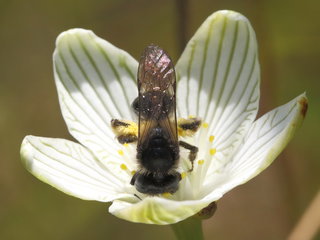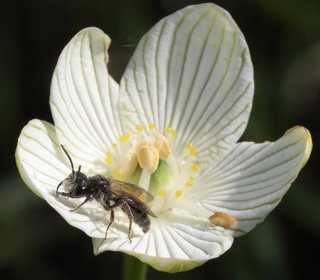
Smithsonian Institution, Entomology Department · 9
Andrena parnassiae, female, face |

Click on map for details about points.
|
| Links | Notes: A very rare species, probably associated with bogs, probably associated with grass of parnassus, and perhaps not seen for quite a number of years. It is notable for having extensive dark hairs on the scutum and the face but pale scopal hairs. More people need to visit bogs in August and September looking for this species...
|
80x5 -
240x3 -
240x4 -
320x1 -
320x2 -
320x3 -
640x1 -
640x2
Set display option above.
Click on
images to enlarge. |

Smithsonian Institution, Entomology Department · 9
Andrena parnassiae, female, side |

Smithsonian Institution, Entomology Department · 9
Andrena parnassiae, female, top |
|

Smithsonian Institution, Entomology Department · 9
Andrena parnassiae, female, wing |

© Copyright source/photographer
· 7
Andrena parnassiae, f on Parnass |
|

© Copyright Micheal Veit 2010
· 6
Andrena parnassiae, female |

Michael Veit · 6
Andrena parnassiae, f on Parnass -- |
|

Michael Veit · 6
Andrena parnassiae, f on Parnass -- |

Michael Veit · 6
Andrena parnassiae, f on Parnass -- |
|

Michael Veit · 6
Andrena parnassiae, m on Parnass -- |

Michael Veit · 6
Andrena parnassiae, m on Parnass -- |
|

Michael Veit · 6
Andrena parnassiae, m on Parnass -- |

Mitchell, Bees of the Eastern United States, Vol. I, 1960 · 1
Andrena parnassiae, figure40h |
|

Mitchell, Bees of the Eastern United States, Vol. I, 1960 · 1
Andrena parnassiae, figure41a |

Mitchell, Bees of the Eastern United States, Vol. I, 1960 · 1
Andrena parnassiae, figure42b |
|
Overview |
Reprinted from:
Cockerell, T.D.A. 1902. XX. North American bees of the genus Andrena. Annals and Magazine of Natural History (7)9: 105. The copyright on this work has expired.
Please report text errors to: Leah at Discoverlife dot org.
FEMALE. Length about 8mm. Black, with copious but thin hair, greyish white on sides and middle of face, occiput, pleura, metathorax, and front of mesothorax, black on clypeus, vertex, mesothorax (except front), scutellum, and postscutellum; head broad cheeks large and shining; antennae black, faintly brownish at tips beneath, first joint of flagellum a little longer than the next two together, apical joint polished and shining above, contrasting with the other joints, which are much duller; clypeus strongly punctured, with narrow median smooth line; process of labrum very low and broad, gently curved; facial foveae scarcely pallid, close to eyes; mesothorax dull, minutely tessellate, with small punctures; enclosure of metathorax dull, coarsely roughened basally, no transverse ridge; tegulae piceous; wings smoky, nervures piceous, stigma brown margined with piceous; legs black, with pale hair, hair on inner side of basal joint of hind tarsi pale brownish; abdomen oval, shining, but microscopically tessellate and impunctate, lateral hind margins of segments 2 to 4 with white hair bands, that on 4 nearly continues in the middle line; fimbria silvery grey.
Hab. Milwaukee, Wisconsin, Sept. 14 (Dr. S. Graenicher).
Dr. Graenicher informs me that it's an oligotropic bee, collecting pollen exclusively from Parnassia caroliniana. He had himself surmised that it was undescribed.
Reprinted with permission from: Mitchell, T.B. 1960. Bees of the Eastern United States. North Carolina Agricultural Experiment Station Technical Bulletin No. 141.
FEMALE. Length 10 mm.; head quite broad, length of face about equal to distance between eyes; eyes subparallel; foveae rather broad above, occupying most of space between eyes and ocelli, somewhat obscure because of dark tomentum, terminating slightly below level of antennae; lateral ocelli separated from margin of vertex by a space nearly twice their diameter; cheeks very slightly broader than eyes; clypeus quite short, protruding only slightly below suborbital line, somewhat shining, punctures scattered and irregular medially, rather sparse, becoming finer and closer toward lateral angles; face below ocelli rather smooth, dull, finely and obscurely striate, vertex smooth but rather dull, with very fine, scattered and irregular punctures, these becoming minute and irregular on the more shining cheeks; malar space hardly evident; process of labrum short and broad, median length no more than one-fourth its width; basal segment of flagellum fully equal to segments 2 and 3 combined, median segments about as long as broad; pubescence of lower portion of face and clypeus, and of thorax laterally and posteriorly, whitish, that on vertex and dorsum of thorax black; scutum smooth but rather dull, punctures very minute, those along anterior half shallow and obscure, becoming somewhat deeper and more distinct but very fine posteriorly, those on scutellum exceedingly minute and obscure; pleura smooth but dull, very finely tessellate; dorsal area of propodeum smooth but dull, lateral areas more densely tessellate, propodeal corbicula well developed, dorsal hairs elongate, with very few inner hairs; trochanteral floccus well developed and complete; legs dark, slender, all basitarsi quite narrow and elongate, pubescence largely. p-ale, but with some obscure dark pubescence on front and mid tibiae, hind tibiae slender and elongate, scopal hairs entirely white, rather dense and elongate; spurs pale yellow; wings subhyaline, veins and stigma brownish-testaceous, 2nd submarginal cell no more than half length of 3rd, receiving 1st recurrent near middle; tegulae dark anteriorly, becoming somewhat testaceous-hyaline posteriorly; abdominal terga smooth, somewhat shining, punctures hardly evident, segments 2-4 rather broadly impressed apically, but the line of division very obscure, apical rims becoming very narrowly hyaline, fasciae very poorly developed, apical fimbria becoming fuscous.
MALE. Length 8 mm.; face fully as broad as long; head very much wider than thorax; clypeus very flat, projecting but very little below suborbital line, dull, finely and very closely punctate beneath rather dense pubescence; space between margin of vertex and lateral ocelli very slightly broader than diameter of ocelli; cheeks very broad, with a rounded subcarinate angle opposite upper third of eye, smooth, with sparse, minute punctures; malar space extremely short; basal segment of flagellum subequal to 2nd and 3rd combined; process of labrum very short and broad, broadly rounded; mandibles elongate, slender, flexed medially, with a distinct, inner, subapical tooth, overlapping nearly one-half; pubescence of head, thorax, and legs pale ochraceous; thoracic integument dull, tessellate, punctures of scutum shallow and rather sparse, surface somewhat more shining posteriorly; punctures of pleura very shallow and quite sparse; enclosure of propodeum quite smooth, less densely tessellate than areas on each side, but narrowly subrugose along basal margin; basitarsi slender and elongate, much narrower than their respective tibiae; 2nd submarginal cell much shorter than 3rd, receiving 1st recurrent slightly beyond middle; abdominal terga quite smooth, somewhat shining, apical margins only very obscurely depressed, rims faintly reddened, punctures exceedingly minute and quite sparse, discal pubescence short, erect, very thin, entirely pale, apical fasciae very poorly developed; apical portion of sternum 8 narrow, with sides parallel, without a ventral median protuberance, apex rather abruptly truncate; penis valves only slightly broader basally than at apex, gonocoxites rather broadly dilated apically, gonocoxal lobes considerably produced, narrowly rounded apically.
DISTRIBUTION. Michigan, Wisconsin and Vermont; August and September.
FLOWER RECORDS. Type material collected on Parnassia.
|
|
|
Names | |
|
|
| Supported by | |
Updated: 2024-07-27 01:39:42 gmt
|